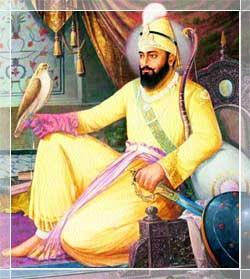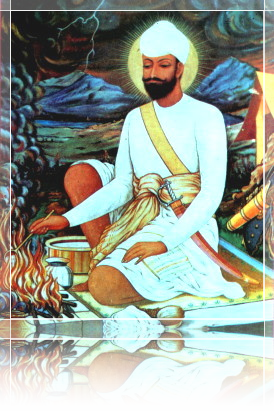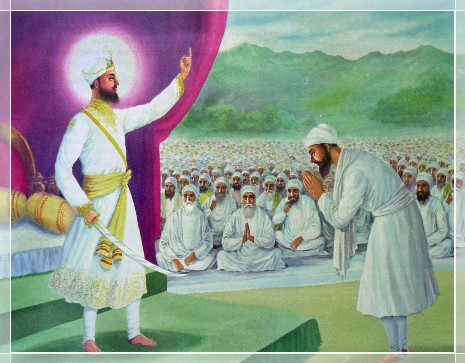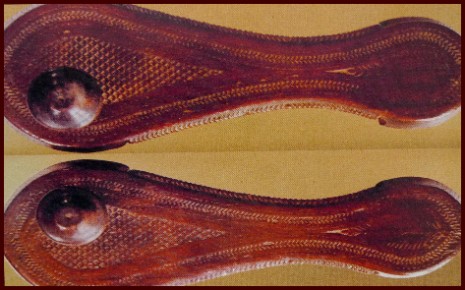namdhari world
Main menu:
- Home Page
- Kuka Faith
- History
- Sikh Gurus
- Namdhari Gurus
- Freedom Fighter - Satguru Ram Singh Ji
- Warrior of Peace
- Non-Cooperation Movement page 1
- Non-Cooperation Movment page 2
- Kuka Postal Service
- No Trial
- Battle for recognition as part of India's struggle for freedom
- Plaque at Ludhiana Railway Station
- Ram Singh Kuka by G.K.Venkateshamurthy
- Social Reforms by Satguru Ram Singh Ji
- Birth of Sant Khalsa
- Kuka Movement - by Film division of Government of India
- KUKA LEHAR - India's first war for independance (1856)
- Satguru Jagjit Singh Ji
- Contradictions
- Historical Quotes
- Vaisakhi - 1699
- Gurmukhi Script
- Sikh Women
- Knowlegde Bank
- Connections
- Places to visit
- Resources
- Music World
- Calendar
- Sports
- ETC...
Siri Guru Gobind Singh Ji
History > Sikh Gurus
Avtar Or Parkash Diwas: Poh Sudi 7,1723 Bikrami Sunday
Date of Birth: 22 December 1666
Place of Birth: Patna Sahib (Bihar)
Gurgaddi Diwas: 12 Magar 1732 Bikrami (11.11.1675) Anandpur Sahib
Alop Diwas: 7.11.1708
Joti Jot Diwas: 1812
Father: Guru Teg Bahadur Jee Mother: Mata Gujree Jee
Wife/Wives: Mata Ajito Jee / Mata Sundri Jee / Mata Sahib Devan Jee
Children: Sahibjade Ajit Singh Jee / Sahibjade Jujhar Singh Jee / Sahibjade Jorawar Singh Jee / Sahibjade Fateh Singh Jee

The tenth Guru, Siri Guru Gobind Singh Ji, was born in 1666 and became Guru after the martyrdom of his father Guru Tegh Bahadur. He created the Khalsa (The Pure Ones) in 1699, changing the Sikhs into a saint-soldier order with special symbols and sacraments for protecting themselves. He fought many wars against oppression. His four sons also gave their lives in defense of their faith. After leaving Nander in 1708 Guru Gobind Singh Ji continued, as previously, to assist his Sikhs in whatever trials they might encounter. Soon after Nander he rescued the two Rajput chieftains Rustam Rao and Bala Rao. Heeding their prayers for assistance the Guru carried them safely out of the Satara fort, each clinging to one of his stirrups. He then took them back to their own area. After freeing the Rajput chieftains the Guru helped the Rajput ruler of Bhadra. He remained in Bhadra until 1755 and then moved to Jind, staying there until 1761. From Jind he proceeded to Patiala where he resided for twelve years and then made preparations to shift to Nabha. In the month of Magh ie January/February 1774 he moved to Nabha and established his residence there in a grove of trees. This remained his home base until his death in 1812. He lived out the remainder of his life under the name of Baba Ajapal Singh and during those chaotic years continued to aid his Sikhs in times of distress ...Until he finally departed this life in 1812.
Follow this link for more on Guru Gobind Singh Ji
Sri Guru Gobind Singh Ji was born at Patna on Saturday, the 22nd of December, 1666. He had remained there for five and a half years. In the absence of his father Guru Tegh Bahadur, he was under the care of his mother, grandmother and his maternal uncle, Kripal. He was brought to Makhowal (Anandpur) to be trained for the office he was going to hold. He was only nine years old when he succeeded to the gaddi at Makhowal after the execution of his father at Delhi In 1675. He was still to educate himself for the duties of his grave office. Fortunately for Guru Gobind Singh, his uncle Kripal was there to train him and to guide the panth in face of the self-interested masands to enable him to stand on his own. However, his education in Persian, Sanskrit and the Adi Granth was not yet complete and he was yet to master the art of horsemanship, archery and war before he was called upon to acknowledge the authority of the Chief of Kahlur (Bilaspur). But Kripal was unwilling to identify the young Guru with any power or authority which in his view might be unjust. Consequently, Guru Gobind Singh had to leave his 'home', Anandpur. The Guru's headquarters were shifted to Paonta, then on the borders of the Sirmur (Nahan) state. There his poetic genius continued to flower and its first fruits suggest his preoccupation with the nature of religious missions and his decision to fight for righteousness. In his treatment of Puranic literature, one may discern his conscious or unconscious attempt to broad-base his mission by an indirect appeal to Hindu tradition. By 1688 he had grown into a determined but not a bitter man and he had become his own master before he was obliged to fight, the first battle of his life, against the Chief of Garhwal. Guru Gobind Singh's success in this battle may be taken as a measure of his sound general ship and of the confidence which he could inspire among a considerable number of his disciples even in his early twenties. After three years at Paonta, Guru Gobind Singh returned to the security of Anandpur with the reputation of a victorious general. He was invited to help the Hill Chiefs who were pretentious enough to free themselves from, the Mughal yoke. The Guru's experience soon disillusioned him with the Chiefs and their politics, and he tried to grapple with the fundamental problems of his mission. His treatment of the avatars in an immensely productive literary creativity and the declaration of his mission in the Bachittor Natak are enough to show that he had come to regard himself as a divinely appointed saviour of dharma which for him meant primarily the faith enunciated and promulgated by Guru Nanak Dev Ji and cherished and defended by his eight successors. He had by now discovered himself.
Guru Gobind Singh's problem was to defend the claims of conscience against any external interference, with the aid of arms if necessary. For this purpose, he had first to 'purify' the panth. The lukewarm or self-interested disciples and the disloyal or corrupt masands must not interfere with the cause of righteousness. The institution of the Khalsa on the Baisakhi of 1699 linked the Sikhs directly with the Guru and no longer through the undesirable mediacy of the masands. The baptism of the double- edged sword demanded the sacrifice of personal interests for the cause of the corporate Khalsa. The wearing of keshas and arms, the rejection of some old customs and the adoption of some new, the strong belief in the uniqueness of the faith of the Khalsa—all made for the sharpening of a distinct socio-religious entity of the Khalsa, and its consciousness among them. They could not be ignored by their neighbors. Guru Gobind Singh’s old antagonist the Chief of Bilaspur could not idly watch growing numbers of the Khalsa who appeared to threaten not only his jealously guarded temporal authority but also the integrity of his ancient dominions, with the help of some neighboring Chiefs; he demanded the evacuation of Anandpur. It took them four years successfully to enforce this demand and that too with the aid of their suzerain, the Mughal Emperor, Aurangzeb. But to Guru Gobind Singh, their success cost not only his 'home' but also the life of many a devoted Khalsa, the lives of all his four sons and his mother. The severest blow had now fallen on him and the year 1705 opened with the most critical days of his life when he was wandering almost alone from place to place with no one to depend upon except his God. Guru Gobind Singh's response to this hopeless situation brings out the essential traits of his character and personality. He re-established his contact with the Khalsa, continued to baptize the Sikhs, defended himself against the arms of Wazir Khan the faujdar of Sarhind, prepared a new recension of the Adi Granh, and wrote a dignified letter to Aurangzeb taking a firm stand on moral grounds, and demanding moral justice. Guru Gobind Singh's 'friendly' relations with the Mughal Emperors, Aurangzeb and Bahadur Shah, which have puzzled a number of historians, meant no more than this: that Guru Gobind Singh wished the Emperors to come to a lasting understanding on his own modest terms which implied the restoration of his 'home', Anandpur, to him as the freedom to continue with his religious mission. Quite in harmony with his basic position, the last two years of his life were spent, among other things, in ensuring the claims of conscience without resorting to arms. The Immediate followers of Guru Gobind Singh refused to acknowledge the authority of a state which had denied moral justice to their Guru. The conflict which now ensued proved eventually to be the death-knell of Mughal authority in the Punjab where the Khalsa of Guru Gobind Singh established their sovereign power and in loving gratitude, they attributed their sovereignty to the grace of God and their Guru, Gobind Singh.

Before the creation of Khasla Panth , dusham padshah Guru Gobind Singh Ji
performed a havan as part of devi pujan in 1697 at Naina Devi mountain.

Creation of the Khalsa

Wooden Sandals of Guru Gobind Singh Ji
Guru Nanak Dev Ji / Guru Angand Dev Ji / Shri Guru Amardas Ji / Shri Guru Ramdas Ji / Shri Guru Arjan Dev Ji / Shri Guru Hargobind Sahib Ji / Shri Guru Har Rai Ji
Shri Guru Har Krishan Ji / Shri Guru Tegh Bahadur Ji / Sri Guru Gobind Singh Ji / Sri Guru Balak Singh Ji / Sri Guru Ram Singh Ji / Sri Guru Hari Singh Ji
Sri Guru Partap Singh Ji / Sri Guru Jagjit Singh Ji